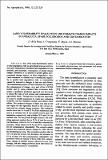Por favor, use este identificador para citar o enlazar a este item:
http://hdl.handle.net/10261/63811COMPARTIR / EXPORTAR:
 SHARE
BASE SHARE
BASE
|
|
| Visualizar otros formatos: MARC | Dublin Core | RDF | ORE | MODS | METS | DIDL | DATACITE | |

| Título: | Land vulnerability evaluation and climate change impacts in Andalucía, spain: soil erosion and contamination |
Autor: | Rosa, Diego de la CSIC; Crompvoets, J.; Mayol Rodríguez, Francisco CSIC; Moreno Arce, Juan A. CSIC | Fecha de publicación: | 1996 | Editor: | Polish Academy of Sciences | Citación: | International Agrophysics 10: 225-238 (1996) | Resumen: | Two of the main desertification indices or land degradation risks in agricultural areas are soil erosion and contamination. Increased land degradation is one possible, and important, consequence of global climate change. Therefore, it is a priority to predict global environmental change impacts on these degradation risks. Land evaluation is a. formal way to develop the capability to predict land degradation risks or vulnerability caused by interactive changes in land use and climate. The fundamental purpose of land evaluation is to predict the consequences of change. As a part of the ACCESS model, and by using standard land evaluation techniques, a qualitative prediction approach was developed to assess the risks of soil erosion and contamination in agricultural lands. Through this bio-physical approach, it is easy to modify parameters to create new evaluating scenarios, run the evaluation models, and observe their effects. The Andalucia Region of Spain was used as the test region for this approach, based on the current climate and two climate change scenarios. The evaluation results show that 16 % and 27 % of the Andalucian land area is at elevated risk of soil rainfall erosion and contamination, respectively; and a further 58 % and 33 % at medium risk. For the present drought scenario, the modelling approach predicts that in 59 % of land the erosion risk decreases, while for 24 % of land this vulnerability increases. These values are 40 % and 60 %, respectively, for soil contamination vulnerability. The second scenario assumes the predicted climate change for 2050 AD for the Mediterranean area. This evaluation predicts that in 18 % of land the erosion risk decreases, and increases in 47 % of land. For the contamination vulnerability the predicted values are similar to those of the first scenario. Thus, change in rainfall amount affected erosion risks strongly, but this change proved to have little direct influence on contamination vulnerability. | URI: | http://hdl.handle.net/10261/63811 | Identificadores: | issn: 0236-8722 |
| Aparece en las colecciones: | (IRNAS) Artículos |
Ficheros en este ítem:
| Fichero | Descripción | Tamaño | Formato | |
|---|---|---|---|---|
| Land vulnerability evaluation and climate change .pdf | 4,48 MB | Adobe PDF |  Visualizar/Abrir |
CORE Recommender
Page view(s)
355
checked on 07-may-2024
Download(s)
135
checked on 07-may-2024
Google ScholarTM
Check
NOTA: Los ítems de Digital.CSIC están protegidos por copyright, con todos los derechos reservados, a menos que se indique lo contrario.
